Men's dress boots in the 1930s reflect a unique blend of style and practicality amidst the Great Depression. You'd find sleek ankle boots made from high-quality leather, often featuring decorative brogue detailing. Versatility became essential, allowing these boots to shift smoothly between casual and formal settings. Iconic brands like Florsheim and Allen Edmonds catered to a desire for durability and style, with prices ranging from $30 to $320. This era's fashion was shaped by Hollywood glamor, influencing the visual appeal of men's footwear. Exploring further reveals how these influences and trends shaped modern designs you see today.
Overview of 1930s Boot Styles
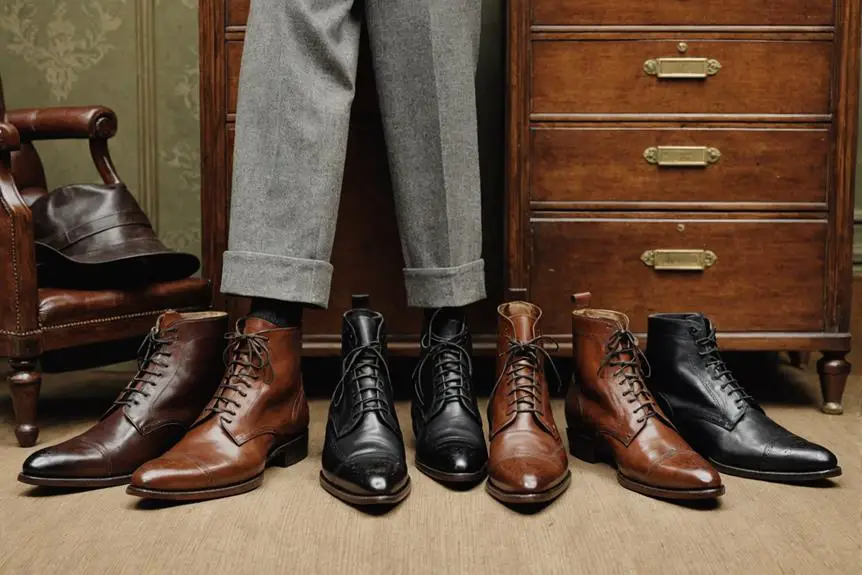
Examining the boot styles of the 1930s reveals a fascinating blend of formality and practicality that defined men's fashion during this era. The decade mainly featured dress boots, particularly ankle boots, which combined elegance with functionality. Crafted primarily from durable materials like Black Leather, these boots were suitable for both formal and casual occasions, showcasing the versatility men sought in their footwear. Many of these boots came with distinctive vintage labels, reflecting their quality and craftsmanship, which are essential for identifying vintage characteristics.
Classic designs, such as tall laced styles, emerged, reflecting a sophisticated aesthetic that complemented tailored suits. However, it was the addition of two-tone color schemes and brogue embellishments that truly set these boots apart, allowing men to express personal style while maintaining a polished appearance.
The rise of innovative styles like the double-tongued German hike boots also marked this period, blending rugged appeal with high fashion. This fusion not only catered to the demands of outdoor activities but also resonated with the contemporary fashion sensibilities of the time. With sizes typically ranging from 8 to 8.5 for men, these boots catered to a broad audience, ensuring that comfort and style were accessible to all.
Key Design Features
In the 1930s, men's dress boots showcased several key design features that balanced style and functionality. You'd notice the sleek silhouette and defined ankle height, merging practicality with elegance. The high-quality leather used in many models not only guaranteed durability but also allowed for unique textures, like suede and exotic hides, adding visual intrigue to your footwear collection.
Decorative brogue detailing was a hallmark of the era, with small holes and intricate patterns enhancing the aesthetic appeal of the boots. This craftsmanship offered a sophisticated touch, showing off your attention to detail. Two-tone color combinations, such as classic black and brown or tan, gained popularity as a way for you to express personal style without sacrificing tradition.
The soles, typically crafted from leather, contributed to both the longevity and refined finish of these boots, assuring that they remained a staple in any gentleman's wardrobe. Styles like wingtips and cap toes emphasized traditional craftsmanship, making each pair not just a piece of clothing but a statement of character. Overall, the 1930s men's dress boots represented a perfect fusion of art and utility, catering to the fashion-forward man of the time.
Popular Brands and Models
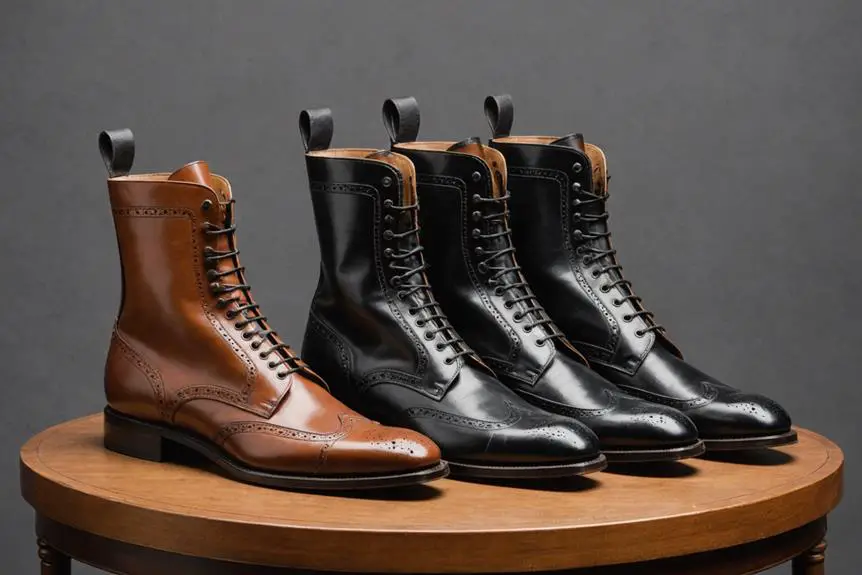
During the 1930s, several brands emerged as leaders in the men's dress boot market, each bringing unique flair and craftsmanship to the table. Allen Edmonds stood out for its high-quality craftsmanship and classic designs, appealing to the discerning gentleman. The Ferro Aldo Arthur MFA139001D model, with its striking black and white wingtip design, captured the essence of the popular two-tone color trend, making it a fashionable choice.
Clarks Whiddon Cap also gained popularity, offering a stylish option in black leather that catered to the well-dressed man of the time. The rise of brogue embellishments became a defining feature of this era, as many models were adorned with decorative perforations, showcasing a blend of style and sophistication.
Here's a quick overview of some notable brands and models from the decade:
| Brand | Model |
|---|---|
| Allen Edmonds | Classic Dress Boots |
| Ferro Aldo | Arthur MFA139001D |
| Clarks | Whiddon Cap |
With premium custom leather boots priced around $74.95, men found a balance between quality and affordability during this stylish decade.
Historical Significance
Men's dress boots from the 1930s serve as a fascinating lens through which we can understand the cultural and economic shifts of the time. The decade marked a change towards more relaxed yet stylish footwear, with designs featuring brogue embellishments and eye-catching two-tone color combinations. This evolution mirrored the desire for practicality and elegance amidst the economic challenges of the Great Depression.
Ankle boots gained popularity, reflecting a need for versatile footwear suitable for both formal and casual settings. The predominant use of leather underscored a commitment to quality and durability, essential traits when resources were scarce. Iconic styles like the black cap toe and wingtip designs didn't just serve fashion; they laid the groundwork for contemporary dress boots.
Brands like Florsheim and Connolly emerged as leaders in the market, establishing a legacy that resonates today. Their emphasis on craftsmanship and high-quality materials not only catered to the demands of the era but also influenced future footwear trends. Fundamentally, these boots encapsulated a unique interplay between style and necessity, making them significant artifacts of 1930s culture and fashion history.
Care and Maintenance Tips

Proper care and maintenance of vintage leather dress boots is essential to preserving their quality and extending their lifespan. By following a few simple practices, you can guarantee your boots remain in excellent condition for years to come. Here are some key tips to keep in mind:
- Clean regularly with a soft cloth to remove dust and dirt.
- Apply a suitable leather conditioner to maintain suppleness and prevent cracking.
- Use shoe trees to help maintain shape and absorb moisture.
- Inspect for signs of wear promptly.
Storing your boots in a cool, dry place is vital. Shoe trees not only preserve their shape but also absorb excess moisture, which can lead to damage. If your boots do get wet, air dry them naturally, away from direct heat sources, to avoid warping. In addition, using a waterproofing spray designed for leather can protect against water damage and stains, but verify it's suitable for vintage materials. Regularly inspect your boots for any signs of wear, such as cracked leather or loose soles, and address these issues quickly to extend their lifespan. Investing time in care will keep your vintage boots looking sharp and stylish.
Pricing Trends and Value
How do the pricing trends of men's dress boots from the 1930s reflect their enduring value in today's market? The economic backdrop of the Great Depression shaped the original price range of $30 to $100, indicating that even during tough times, quality footwear was prioritized. Premium brands like Florsheim and Connolly offered boots priced between $80 and $320, showcasing a commitment to craftsmanship.
Today, vintage ankle boots from the 1930s, particularly black leather lace-ups, command prices between $97.49 and $375.00. This substantial increase highlights their collectible status and the nostalgic appeal they hold. The condition and historical significance, especially for items like WWII-era ski boots priced at $169.99, further contribute to their desirability among collectors.
In the modern market, you can find 1930s-inspired boots ranging from $49.99 for spectator shoes to $115.00 for premium custom leather options, illustrating a sustained interest in vintage styles. The ongoing demand not only reflects the quality and design of these boots but also suggests that they continue to resonate with contemporary consumers, solidifying their place as timeless pieces in men's fashion.
Fashion Influences of the Era
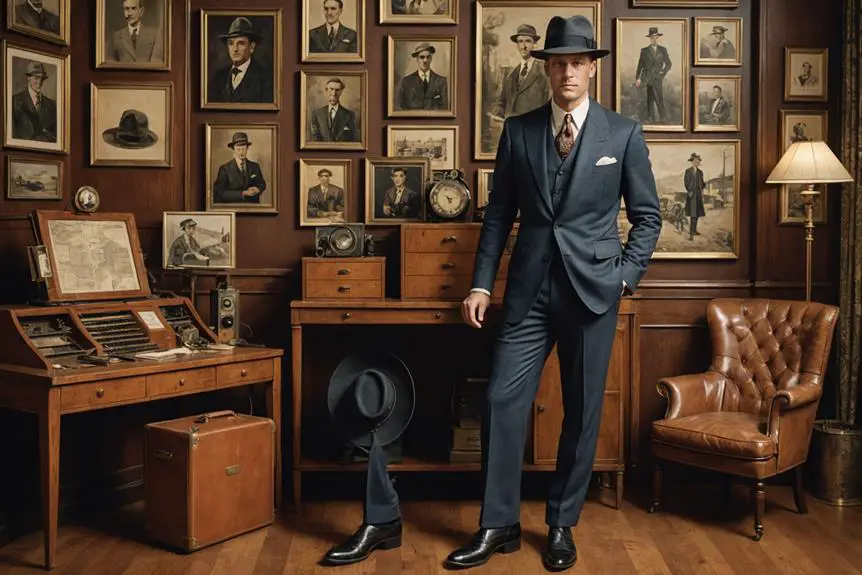
The fashion landscape of the 1930s, heavily influenced by Hollywood glamor, transformed men's dress boots into symbols of style and sophistication. As you navigate this era, you'll notice significant shifts in footwear trends that reflect broader societal changes.
- Two-tone color combinations became a popular choice, enhancing visual appeal.
- Brogue embellishments added decorative perforations, elevating the aesthetic of dress boots.
- Leather emerged as the dominant material, emphasizing both durability and craftsmanship.
- Ankle boots gained traction for their versatility across various occasions.
This decade's fashion embraced a more relaxed yet stylish approach, mirroring the carefree spirit of Hollywood's leading men. The introduction of two-tone designs, particularly black/white and brown/tan, showcased a playful yet refined elegance. Brogue detailing further distinguished these boots, appealing to the modern man's desire for individuality. With leather reigning supreme, the focus on craftsmanship guaranteed that these boots not only looked good but lasted long.
Economic factors also played a role, leading to a preference for practical footwear. Ultimately, the 1930s solidified men's dress boots as essential components of a well-rounded wardrobe, balancing style with functionality.
Frequently Asked Questions
What Shoes Did Men Wear in the 1930s?
In the 1930s, you'd see men wearing a variety of shoes, including polished dress boots, comfortable loafers, and rubber-soled sport shoes, each style reflecting the era's blend of formality and emerging casual trends in footwear.
What Accessories Did Men Wear in the 1930s?
In the 1930s, you'd see men sporting bold ties, elegant pocket squares, and intricate cufflinks. Hats like fedoras completed their look, while sleek wristwatches balanced style with practicality, reflecting the era's fashion-forward mindset.
When Did Men Start Wearing Boots?
You'll find that men started wearing boots in the late 19th century, primarily for work and outdoor activities. Over time, boots evolved into fashionable staples, reflecting changing styles and increasing versatility in men's wardrobes.
What Colors Did Men Wear in the 1930s?
In the 1930s, you'd notice men wearing darker shades like black, brown, and burgundy. Earthy tones and lighter summer colors also emerged, reflecting a shift towards vibrant hues in everyday fashion and formal attire.
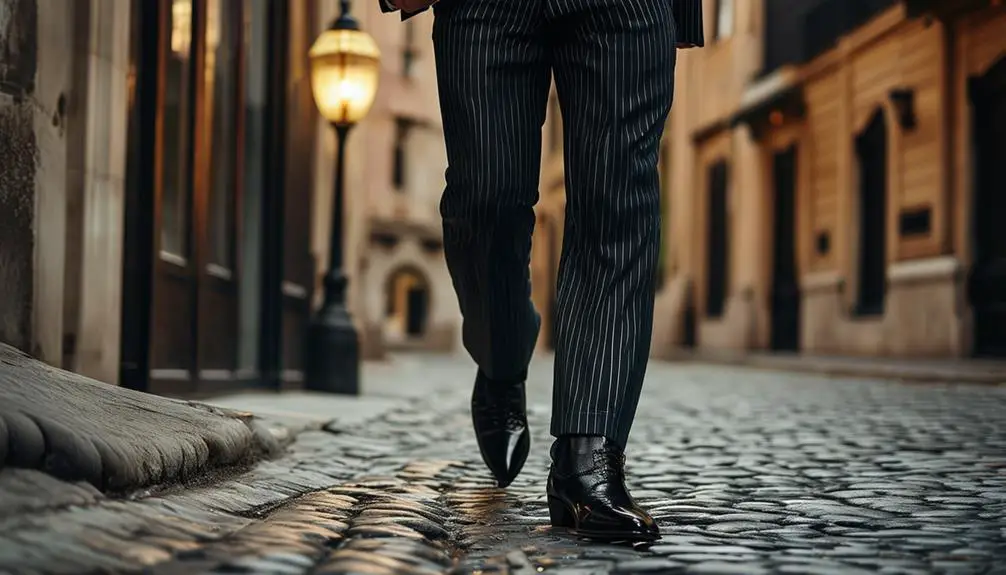

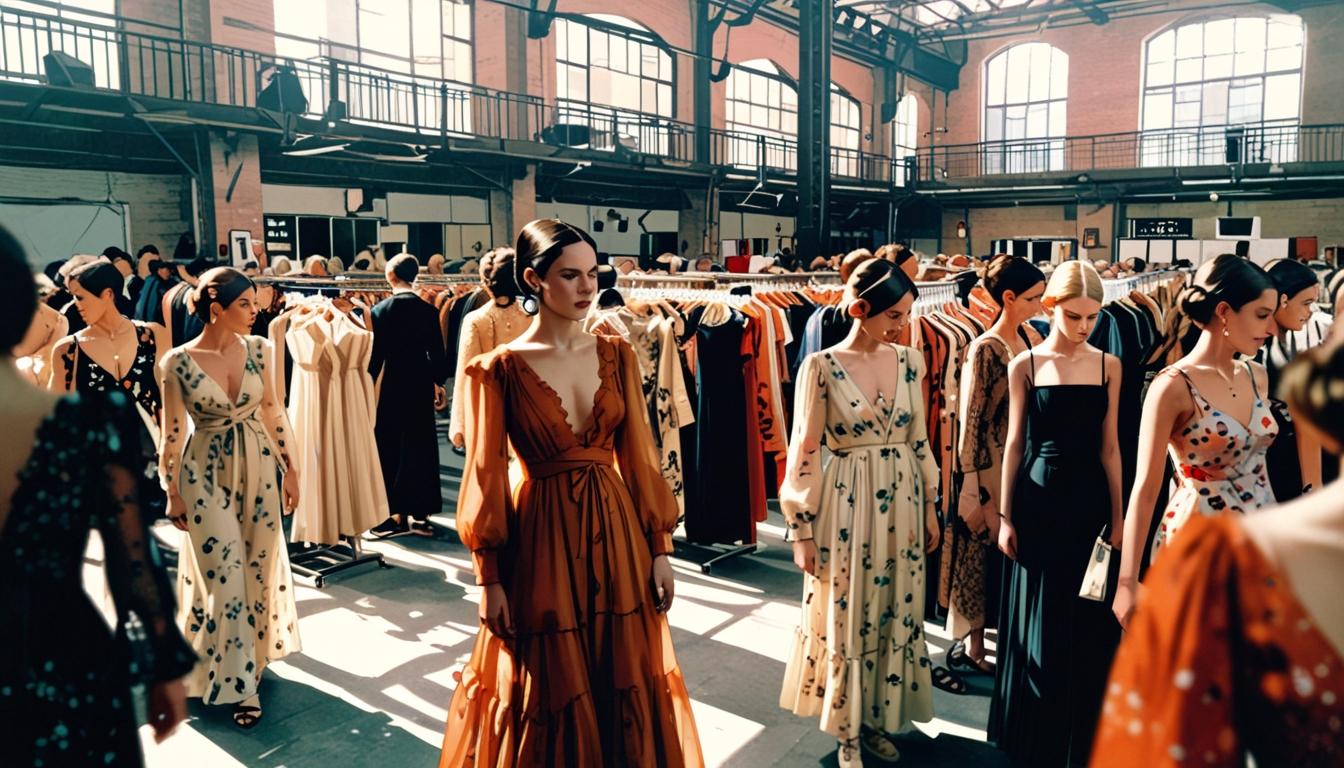
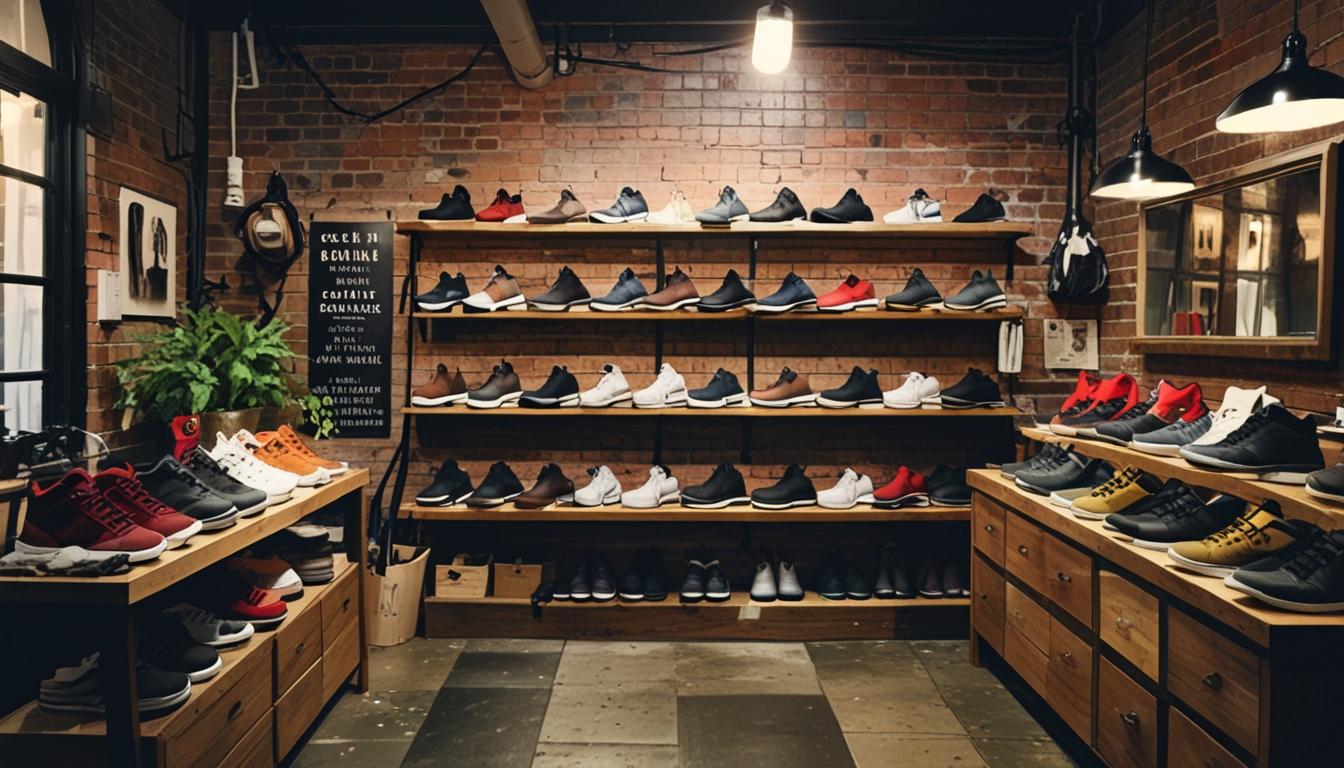

Thanks for every other informative blog. Where else may I get that type of info written in such a perfect way? I have a challenge that I’m simply now running on, and I have been on the look out for such information.